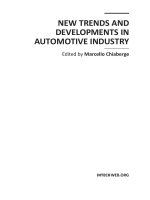New trends and developments in automotive industry Part 8 doc
Bạn đang xem bản rút gọn của tài liệu. Xem và tải ngay bản đầy đủ của tài liệu tại đây (3.69 MB, 30 trang )
New Trends and Developments in Automotive Industry
200
Solving the above equations by simple mathematical operations, we obtain that
(
)
||
|| ( ) 1
T
f
p
∗
=
−
*
λ
WD
f
Ws (27)
11
|| ||
|| () () ( || )
TT
ff
p
−−
∗∗∗∗
==
f
D
f
D
f
WWD
f
Ws (28)
The equation (24) is not in a convenient form for computation since the desired vector
f
*
is
implicitly in the right side of the equation
f
*.
However, it suggests that an iterative algorithm
for estimation of the optimal vector
f
*
is given as:
1
|| ||
(1) () ( () )
TT
ff
kk k
−
+=
f
DWWDWs (29)
where
222
|| 1 2
() {| ()| ,| ()| ,| ()| }
ppp
fn
kdiagfkfkfk
−−−
=D (30)
The above algorithm, called the generalized FOCUSS algorithm can be expressed in a more
compact form:
||
(1) ()[ ||()]
f
kkfk
+
+=
f
DWD s (31)
where the superscript ( . )
+
denotes the Moore-Penrose pseudo-inverse and
1/2 1/2 1/2
1/2
|| 1 2
||
() () {| | (),| | (),| | ()}
ppp
fn
f
kkdia
gf
k
f
k
f
k
−−−
==
DD (32)
It’s should be noted that the matrix
D
|f|
exists for all f and even for a negative p. For p=2, the
matrix
D
|f|
=J and the FOCUSS algorithm simplifies to the standard LS or the minimum 2-
norm solution:
1
()
TT−
∗
=
f
WWW s
(33)
3. Results
The system of equations describing the tomographic flowmeter was solved with the aid of
Linear Least Squares method for overdetermined algebraic set of equations. With the
method called FOCUSS (FOCal Underdetermined System Solver) I have solved a system of
underdetermined algebraic set of equations.
Condition number of the resulting rectangular matrix was high enough so that the classical
Kaczmarz’s algorithm was not able to produce correct results. That’s why I have to take into
account pseudo rank deficiency of the matrix coefficients. I have considered all possible
candidate solutions, when k was changing from 1 till the full pseudo – rank equal to 1000
(Polakowski at al., 2008, a).
The images and their relief plots constructed on the basis of the candidate solutions are
presented in Figure: 4b, 6b and 7b. The images and their relief plots constructed on the basis
of FOCUSS are presented in Figure: 4c, 5b, c, d, 6c and 7c.
Tomography Visualization Methods for Monitoring Gases in the Automotive Systems
201
Fig. 3. Diagram ║
r
(k)
║=f(║f
(k)
║)of the residual vector norm versus the solution vector norm
for the cross shaped object
The resolution of grid 16x16, number of
the rays 256
The resolution of grid 16x16, number of the
rays 624
a)
b)
c)
Fig. 4. The changes of images and the relief plots of a cross shaped object in dependence of
number of the rays a) reconstructed object, b) reconstruction with the aid of Linear Least
Squares Method , c) reconstruction with the aid of FOCUSS
New Trends and Developments in Automotive Industry
202
a)
b)
c)
d)
Fig. 5. Images and the relief plots of a cross shaped object reconstructed with the aid of
FOCUSS in dependence of regularity index a) reconstructed object, b) regularity index 0.02 ,
c) regularity index 0.2, d). regularity index 50.
When I compare Figure: 5b, c and d we can also see, that the images have not been
improved with the bigger regularization parameter, when the resolution of the grid was not
to high.
Inspecting those images we can observe the influence of the resolution of the square greed
and number of the rays on the object forming inside the region. The influence of resolution
and number of the rays on improving the image we can clearly see on Figure 4, 5, 6 and 7.
The resolution of grid 32x32, number of the
rays 256
The resolution of grid 32x32, number of the
rays 512
a)
b)
c)
Fig. 6. The changes of images and the relief plots of a cross shaped object in dependence of
number of the rays a) reconstructed object, b) reconstruction with the aid of Linear Least
Squares Method , c) reconstruction with the aid of FOCUSS
It is worth to mention, that shown in Figures: 4÷7 achieved results were constructed for
unpolluted synthetic data and the images were not filtered in order to check the behaviour
of the image construction algorithm.
Theoretical and experimental researches carried out in this work prove that by increasing
the number of radiuses which cross the pipe we increase the number of rows in the
coefficient matrix
W. It causes the results improvement, but at the same algorithm’s
Tomography Visualization Methods for Monitoring Gases in the Automotive Systems
203
The resolution of grid 64x64, number of
the rays 256
The resolution of grid 64x64, number of
the rays 512
a)
b)
c)
Fig. 7. The changes of images and the relief plots of a cross shaped object in dependence of
number of the rays a) reconstructed object , b) reconstruction with the aid of Linear Least
Squares Method , c) reconstruction with the aid of FOCUSS
execution time. Thus the number of rays should be selected in reasonable and considered
way, thinking about image’s quality and algorithm’s execution time. By increasing the size
of the resolution of the square greed (increase number of pixel) we cause a rise of the
number of columns in coefficient matrix
W. On the other hand, with higher resolution of the
square greed, reconstructed object could have more details and it is more similar to the real
object. We should notice that with higher resolution of the square greed, the number of rays
has to be increased proportionally.
After checking the behaviour of described above the image construction algorithms we tried
to receive a velocity profile of the flow. For receive a velocity profile computations were
made in area of a pipe with 0,20 m diameter. In the model transmitters (N=32) and receivers
(O=48) were evenly distributed around cross-sectional area of the pipe as shown in Fig. 8.
In analyzed model the transmitters one by one generates ultrasound impulses, which with
different delays reach all receivers (Polakowski at al., 2008, b).
This work contains examples of simulation computations of the complex shape modelling
the flow with complicated 3D shape (Fig. 9). Chosen methods made it possible to obtain
tomographic images that accurately map tested shape (Fig. 11).
The tested area with modelled object was divided into 5 surfaces (Fig. 10). In each surface
were made 32 projections with help of 32 x 48 rays between 32 transmitters and 48
receivers in each surface. In all surfaces were made calculations, which gave tomography
images of calculated area. On figure 9 are shown only 9 from all achieved results with
their relief plots.
From these 2,5 D results we can quite accurately reconstruct the whole 3D modelled flow
shape.
The system of equations describing that tomographic imaging was solved with the aid of
Linear Least Squares Method. Condition number of the resulting rectangular matrix was
high enough so that the classical Kaczmarz’s algorithm was not able to produce correctly
New Trends and Developments in Automotive Industry
204
results (Polakowski at al., 2008, b). That is why I have to take into account pseudo rank
deficiency of the matrix coefficients. I have considered all possible candidate solutions
according Eq. (21), when k was changing from 1 till the full pseudo–rank.
Fig. 8. Modelled area divided with 32x32 pixels and evenly distributed transducers: 32
transmitters N x 48 receivers O
Tomography Visualization Methods for Monitoring Gases in the Automotive Systems
205
Fig. 9. All possible 1536 rays in modelled cross-sectional area from 32 projections between 32
transmitters and 48 receivers
New Trends and Developments in Automotive Industry
206
Fig. 10. Model of the complicated flow shape and its 2,5D visualization
Tomography Visualization Methods for Monitoring Gases in the Automotive Systems
207
5 10 15 20 25 30
5
10
15
20
25
30
0
10
20
30
40
0
10
20
30
40
0
2
4
6
8
10
12
a) b)
5 10 15 20 25 30
5
10
15
20
25
30
0
10
20
30
40
0
10
20
30
40
0
2
4
6
8
10
12
c) d)
Fig. 11. Two examples of obtained tomography images with their relief plots in W1 (a, b)
and W2 (c, d) surfaces used for reconstruction of the flow in 2,5 D
I also have performed calculations for noise polluted data. The noise was generated
according to algorithm where the changes in rays flow were achieved through changing the
position of transmitters and receivers according to Eq. (33), where in case of noise a random
number l
los
with weight w was added to n
y
coordinate l
los
was within the <0, 1> scope and
was calculated by random numbers generator.
(0,5)
yy
los
y
nnwl n
=
+− (33)
After that the value was reduced by 0,5 in order to get positive or negative values.
In this case even data with high noise haven’t caused big image deformation. It is an
essential fact, because real data consists of noise from measurement errors.
The obtained tomography images (Fig. 11) confirm that chosen method gave us images that
accurately map tested shape.
New Trends and Developments in Automotive Industry
208
3. Conclusion
The calculations with use of the modelling in 2,5D space, give a chance to get results which
reflect the phenomenon in the analyzed 3D area, quite accurately (Fig. 9). The obtained
results are satisfying and further work should be given the answer for the question, if the
proposed method will finding practical application in automotive applications. The
simplification of calculations with assuring the sufficient accuracy in making tomography
images of analyzed physical phenomenon should succeed in faster obtaining of results. This
issue is important because the contemporary tomography is expected to bring real time
tomography images of dynamically changing environment.
4. References
Gorodinitsky I.F., George J.S and Rao B.D., (1995), Neuromagnetic source imaging with
FOCUSS: a recursive weighted minimum norm algorithm, Clinical Neurophysiology,
vol. 95, pp. 231-251
Kak A., C., Slaney M. (1999) Principles of Computerized Tomographic Imaging, IEEE Press,
ISBN: 0-87942-198-3
Kupnik M. (2008) Ultrasonic Transit-time Gas Flowmeter for Automotive Applications, VDM
Verlag Dr Műller, ISBN: 978-3-639-00789-3
Lawson C. L., Hanson R. J. (1995) Solving Least Squares Problems”, Classics in Applied
Mathematics 15, SIAM
Opieliński K., Gudra T. (2006) Recognition of external object features in gas media using
ultrasound transmission tomography, Ultrasonics, 44, pp.1069-1076.
Mandard E., Kouame’ D., Battault R., Remenieras J. P., Patat F. (2008) Methodology for
Developing a High-Precision Ultrasound Flow Meter and Fluid Velocity Profile
Reconstruction, IEEE Transactions on Ultrasonic, Ferroelectrics and Frequency
Control, vol. 55, no.1, pp. 161-171
Polakowski K., Sikora J., Filipowicz F.S. (2007) SVD for image construction in ultrasound
tomography, The International Conference on “Computer as a Tool” EUROCON,
Warsaw, pp. 276-281, a
Polakowski K., Sikora J. (2007) Visualization and image analysis problems in multipath ultrasonic
tomography, 5th World Congress on Industrial Process Tomography WCIPT5,
Bergen, pp. 941-948, b
Polakowski K., Sikora J., Filipowicz F.S. (2007) Idea of 3D Imaging Based on 2,5D Tomography
Reconstruction Approach; 16th International Conference on Systems Science ICSS’07,
Wrocław, vol. 3, pp. 206-211, c
Polakowski K., Sikora J., Filipowicz S.F. (2008) Computer Methods in Monitoring of Flow
Processes in Car Systems, ZKwE, Poznań, April 14-16, pp. 185-186, a
Polakowski K., Sikora J., Filipowicz S.F., Rymarczyk T. (2008) Tomography Technology
Application for Workflows of Gases Monitoring in The Automotive Systems, Przegląd
Elektrotechniczny, R. LXXXIV, 12/2008, pp. 227-229, b
Roger C. Baker (2005) Flow Measurement Handbook, Cambridge University Press, pp. 312-351
13
FlexLean - Flexible Automation for
Automotive Body Assembly
Sven Soetebier
1
, Nicolas Mauser
1
, Fabrice Legeleux
2
and Sönke Kock
3
1
ABB Corporate Research Center
2
ABB R&D BIW
3
ABB Corporate Research
1
Germany
2
China
3
Sweden
1. Introduction
The automotive industry has pioneered the large scale use of robots. Long production runs
of identical car bodies were the ideal field of application for early industrial robots, and spot
welding lines with hundreds of robots have become a familiar sight. However, a lot of the
production equipment is still based on hard automation. Today’s market is increasingly
putting automobile manufacturers under pressure to offer customers more choice of
products and variants with decreasing life cycle, while at the same time demanding lower
production costs. To fulfill these apparently contradictory requirements, a single line must
be able to produce a mix of different models, and must “learn” to make new models without
calling for a total re-design of its equipment – and preferably without even stopping
production (“rolling launches”).
To responded to these demands it is necessary to make the automotive body assembly more
adaptable, easier to install and more economic on space. This can be achieved with the
presented concept (FlexLean) that introduces modular and highly flexible solutions based
on modular, standardized components consequently in all levels of the automation (Negre
& Legeleux, 2006).
First of all the line is based on standardized and freely configurable cell modules. The
complete line is made up of these highly flexible modules which are connected by a material
handling track motion and standard communication interfaces only. The cells again achieve
their high flexibility through a rigorous utilization of robot technology, not only for
handling and welding with robots but also for clamping and fixturing systems. Key
elements are here programmable flexible positioners, called FlexPLPs. These positioners can
have depending on requirements different types of kinematics with one up to four axes and
replace the tooling equipment used today for locating, handling and fixing car bodies or
other parts. A special Deltapod kinematic is described in more detail that combines high
accuracy and stiffness with an excellent compactness and light weight. To fulfill the wide
range of requirements on the flexible positioners for the totally different tasks in the car
body assembly they are built based on standardized components. A concept will be
New Trends and Developments in Automotive Industry
210
proposed how different types of positioners again can be designed automatically based on
the standard components matching exactly the requirements of the process like workspace,
load, stiffness, accuracy. Finally such a flexible automation system needs a control concept
that allows the engineering and programming of the cells with minimal effort for the line
builder and customer. The proposed control solution profits directly from the concept of the
modular and standardized cells. This allows also a very modular control concept based on
standardized control modules. Going this way consequently to the end, it will be shown that
it is even possible to replace the classical programming by only simply configuring the
desired behaviour of the components up to the sequence of a whole cell.
Fig. 1. Assembly line based on standardized modular cells
2. The FlexLean concept
2.1 Flexible and modular assembly line
With FlexLean an automotive body assembly line is composed out of freely configurable
and standardized cells (see Fig. 1). Each of these cells is a modular robot cell where all
equipment from the robots up to the controllers and cabling are pre-mounted on a platform.
Every cell has its own control and operational system responsible for all operations in the
cell from robot movements, part handling and transport of the car body up to the whole
production cycle. A cell is connected to its neighbouring cells only by a standardized
communication interface for handling the handover of parts from on cell to the next and by
a handling track motion for the car body. In this way every cell is a standalone system that
can, if necessary, be replaced very easily by another cell module at any time or new cells can
be introduced in the line to adapt to extended requirements, new processes or a new type of
car model.
FlexLean - Flexible Automation for Automotive Body Assembly
211
Fig. 2. FlexLean standardized cell with 6 robots, track motion and positioners for multi-
model car body assembly
Fig. 2 shows a schematic layout of such a standardized cell. It can have a different number of
robots (typically 2 to 6) that can be equipped with a choice of predefined process packages
(like spot welding, material handling, sealing ). Further it can have e.g. a different number
of manual loading stations. For the part handling of the car body in the cell and between the
cells a robot like servo controlled track is used enabling for precise and high speed part
transfer. Further key elements of the standard cells are the programmable flexible
positioners that replaces fixed tooling equipment used today holding and fixing car bodies
on the track motion as well as for holding and handling of parts in the cell .
2.2 Flexible positioning and gripping
A car body is made out of 300 to 500 parts (Wemhöner, 2005). Robotized spot welding is the
most common process to reliably join the parts; to secure the geometry of the car, every part
has to be held in place by a fixture prior to welding. The accuracy and stiffness of fixturing
of the shaped metal sheets defines the final quality of the car body geometry.
To achieve this, the cars are built often on top of skids which are transported by a conveyor
through the factory (see Fig. 3). These skids have some drawbacks: first of all they need to be
returned to the beginning of the line after finishing the car. Since they are not flexible and
assigned to one car model only, they need to be exchanged when changing to another car
model. This requires heavy skid handling equipment in the line and a lot of place for storing
the different types of skids. The effort for this explodes with the number of car models
produced in one line.
In FlexLean the traditional conveyors have been replaced by the already mentioned track
that transports the car body from on cell to the next only. The proposed flexible and lean
approach is to avoid car model specific tooling altogether and replace them by fixtures with
programmable geometry that can adapt to any car body. This is achieved by the flexible
programmable positioners (FlexPLP) replacing every pole carrying a locator by a positioner.
New Trends and Developments in Automotive Industry
212
Fig. 3. A model specific skid (pallet) with fixtured car underbody on roller table
Thus instead of the skids a number of FlexPLP is mounted on the track carrying the car
body from one cell to the next (see Fig. 4 in the background). In the cell again fixed mounted
flexible positioners take over the car body from the track motion allowing the track motion
to get the next car body from the previous cell (see Fig. 4 in the foreground).
Fig. 4. Car body on track motion carried by flexible positioners (background) and flexible
positioners taking over the car body in the next cell (foreground)
As for the handling of underbodies/car bodies it is also necessary to find a new solution for
the part handling in the cell. Today mostly geometric grippers are used, which can already
have a modular structure but are restricted to a fixed geometric shape for only one part. To
achieve the required flexibility to adapt to different sizes of parts for different car models, it
is possible in the same way as for the skids to replace the fixed locators off the geometric
grippers with programmable positioners. Fig. 8 shows examples for such a type of highly
flexible geometric gripper with different types of flexible positioners that will be mounted
on robots. Since all them use robot technology they can be programmed and controlled like
the conventional robots integrated in each car body assembly cell.
3. Flexible positioners
3.1 Conventional Cartesian positioners
The obvious approach to build a 3-axis positioner for carrying the pin locators and clamping
tools typically used for positioning and fixing car body parts is based on a Cartesian
arrangement of single linear axis modules.
FlexLean - Flexible Automation for Automotive Body Assembly
213
Such a design involves low design and engineering complexity on one hand which make
them quite easy to use for stationary positioner arrangements. Furthermore they allow for
robust and dust protected designs which can be easily scaled for different workspace sizes
on each axis separately. But on the other hand this concept involves quite high masses and
inertia for a certain level of stiffness which implies directly less suitability for mobile
application e.g. the positioners are mounted on the track motion based part transfer system
or mounted on a flexible gripper which is attached to the robot. Furthermore the TCP of
Cartesian positioner axes can hardly reach out of the footprint without a tremendous design
effort which is also required for positioner applications on mobile servo shuttles in order to
allow for a short part transfer time.
3.2 Positioners based on parallel kinematic machines
After a screening of machine concepts that would fulfill the requirements, especially the
small footprint and the fact that the TCP will have to move outside the footprint, posed a
challenge. It became obvious that the combination of requirements called for a parallel
kinematic machine (PKM) concept, but none of the known kinematics became an obvious
candidate.
3.2.1 The 3 dof challenge of parallel kinematic machines
The 3-UPU machine – based on a characteristic kinematic chain using an universal joint U,
and one prismatic joint P afterwards and then another universal joint U – was first
introduced by Tsai (Tsai, 1996). It looks strikingly simple and promises to be a very lean and
low cost machine for pure translational motions compared to the well known Hexapod, as it
uses only 3 instead of 6 variable length struts and blocks the unwanted rotational degrees of
freedom by using universal joints. Many researchers have built 3-UPUs and reported
interesting results, but the main problem remains that the struts experience very high
rotational moments, which results almost unavoidably in a low stiffness, or in a very bulky
design. Surprisingly, this fact has not been widely published in terms of real measurements.
After prototyping a simple 3-UPU machine, this option was ruled out, and it became clear
that 6 legs are needed to avoid torsional moments and get high stiffness. Using Hexapods
for translational motions, however, is not an option either in applications that are sensitive
to cost. The need for extra motors, cables, power amplifiers and control prohibits the use of
Hexapods in purely translational applications in most cases. Other machines for 3-axis
translational motions use fixed strut length and linear motions that would either violate the
footprint constraint (by moving the foot points horizontally) or the requirement to have a
workspace area bigger than the footprint (by moving the foot points vertically up).
A Delta machine (Clavel, 1988) would come closest, but still could not be made compact and
stiff enough. So the only feasible machine would be a combination of Delta (for 3-axis
motion) and Hexapod (Gough & Whitehall, 1962) (for stiffness and footprint). Such a
machine would use parallelograms in a Delta configuration that could be changed in length
by a single motor and pivot around 2 axes. Unfortunately, such parallelograms did not exist
so far, and it was not obvious how to design them.
A parallelogram that can be extended and retracted by a single motor can be made out of
two cylinders with ball screws and a mechanical coupling, like gears or belts. If such a
parallelogram is required to pivot around two axes, the distance between the cylinders
changes and things become more complicated. Nevertheless, several solutions were
developed by the authors, and the most compact one was chosen (see Fig. 5). The coupling
New Trends and Developments in Automotive Industry
214
uses a sequence of bevel gears and a synchronization belt to accommodate for the
parallelogram’s pivoting motion (patent pending). Four universal joints provide the
required degrees of freedom.
Fig. 5. FlexPLP based on pivotable extensible parallelogram actuator module (left) and its
application on a twisted Deltapod mechanism (right)
3.2.2 The Deltapod positioner kinematics
With the parallelogram actuator required machine element in place, a variety of PKMs can
be synthesized. According to the above requirements, the Deltapod was constructed, which
is based on the Delta geometry with equilateral triangles defining the position of the
alignment of the joints on the base and on the moving platform.
However – due to the small footprint and the offset length of the cylinders, a symmetrical
Delta configuration exhibits an insufficient stiffness in horizontal direction, and would be
badly-conditioned. The solution here was to twist the base joint positions points around the
center axis of symmetry, and to twist the upper platform joints in the opposite direction,
while at the same time reducing the diameters of the principal circles that define the
geometry (see Fig. 6).
Fig. 6. Compacting footprint by twisting joint axes positions from the classic delta (left) to
the twisted delta (right) configuration
FlexLean - Flexible Automation for Automotive Body Assembly
215
The result of this operation is that the machine is compacted, while the condition number
remains almost identical – hence stiffness and velocity relations are not affected. The only
drawback of this operation is that a twist torque on the plat-form is created due to loss of
symmetry. It turns out, though, that this can be easily compensated by anti-rotational
measures of the legs – the resulting torsional moments in the legs are much lower than in
the 3-UPU design. As a result, a very compact and strong PKM is achieved, and it was
possible to meet all of the requirements for the flexile underbody fixturing application.
3.2.3 T-pod4- positioner kinematics
Parallel kinematic machines offer an inherent modularity. It is therefore natural that for any
new PKM concept, a variety of derivatives exist.
In the given case, we derive the T-pod based on the developed parallelogram module, by
aligning two parallelogram planes such that the upper joints form (nearly) a single line,
hereby blocking two rotations, and by placing the third parallelogram plane perpendicular,
(see Fig. 7). The name was chosen because the joint locations on the movable platform
resemble a T-shape.
The advantage of this machine is the reduced footprint in one direction, so that it can be
place in very narrow spaces, but in particular the possibility to remove the synchronization
and add an extra motor to the perpendicular parallelogram, so that an optional tilt motion
around the symmetry axis can be introduced leading to the T-pod4 configuration. This can
be particular useful when fixturing buckled car body parts. The T-pod4 is somewhat related
to the Kanuk (Rolland, 1999), even though the drive mechanism is different.
Fig. 7. A T-pod with 3 d.o.f. (left) and a T-pod4 with 4 d.o.f.(right)
3.2.4 Flexible grippers based on positioners
Combining e.g. four of those T-POD positioners to a common backbone attached to a
powerful handling robot a flexible programmable gripper can be achieved which provides
an excellent payload compared to its own mass (see Fig. 8).
By use of flexible grippers the part logistics within highly flexible car body assembly lines
which is another big issue become addressed. With flexible grippers’ space and cycle time
consuming tool changing of different grippers as well as additional grippers themselves can
New Trends and Developments in Automotive Industry
216
be abandoned. Different from typical tool (gripper) changing a flexible gripper will be
reconfigured according to the part geometry of the successive car model during the transfer
motion of the handling robot without affecting the primary processing time.
Fig. 8. Flexible Gripper Examples T-pod based (left) and hybrid linear module based
attached to a handling robot (right)
4. Engineering of flexible postioners
4.1 Application specific positioner requirements
For the concept for a flexible multi-model car body assembly line presented in this chapter,
positioners are used for different applications: These are stationary flexible fixtures, mobile
flexible fixtures on the shuttle and mobile flexible grippers. Each application involves
different requirements which need to be reflected by an adequate design and configuration
of the positioner mechanism. Both the serial Cartesian as well the parallelogram actuator
basing parallel mechanisms can be optimized and dimensioned towards these requirements.
Flexible Fixtures
stationary/mobile
Flexible Gripper
mobile
Repeatability ± 0.05 mm ± 0.1 mm
Speed 100 – 250 mm 100 mm
Reach per axis 200 – 400 mm 100 – 200 mm
Stiffness > 1 N/μm > 1 N/μm
Mass 50 – 130 kg 20 – 40 kg
Payload Dynamic 30-50 kg 5 – 30 kg
Payload Static 150 kg 55 – 100 kg
Table 1. Examples for positioner mechanism related requirements with respect to
application
Choosing the optimal mechanism dimensions for the best performance is still a challenging
task because variations of the geometric parameters lead to greater variations of the machine
FlexLean - Flexible Automation for Automotive Body Assembly
217
performance than for conventional serial structures. Furthermore there are a lot of
performance criteria which have to be taken into account. Another problematic issue is to find
global values for criteria which depend on the pose of the working platform of the mechanism.
The most important requirements on PKM especially but not only for tooling applications
are workspace, accuracy, stiffness, velocity and lifetime. But these keywords must be looked
at more precisely and put into mathematical expressions. The characteristic functions allow
establishing performance criteria and help to recognize the degree of fulfillment of a PKM
structure with regard to the requirements (Tsai, 1999).
Typically all requirements and developed characteristic functions assigned to PKM
structures are generally not constant or isotropic, but depend on the location or pose
(position and orientation) of the working platform in the plane or space. Isotropic behaviour
is strongly desired, but is a subsequent task of selection, often in coherence with optimizing
procedures. Almost all performance criteria depend on the position and orientation of the
TCP of the PKM. However, in an optimization design process we have to compare and
assess different parameterized kinematic structures using global criteria characterizing the
structural behaviour inside of the workspace (Krefft et al., 2005) (Gosselin, 1998).
Since these complex calculations are mainly reserved to mechanism experts it is hard to use
the inherent modularity of PKM to full potential in view of the requirements give by each
single tooling application.
Fig. 9. Schematic architecture of mechanism engineering tool
4.2 Tool concept for efficient positioner engineering
One promising approach is a software tool based methodology that enables an efficient
engineering of optimized modular mechanisms for tooling applications based on flexible
positioners and grippers. In general it should support the specifics of parallel mechanisms
but it is preferably also extendable to serial and hybrid kinematic mechanisms.
New Trends and Developments in Automotive Industry
218
According to the concept of the engineering tool the user has to provide all available
application related information where the tooling is required for, but the user does not need
to provide mechanism design expertise (see Fig. 9). The tool is mapping application specific
requirements to an adequate layout of mechanism subsystems and their optimized
configuration via defined characteristics functions.
A selection and optimization sub routine ensures to find the best possible mechanism
solution in terms of technical requirements but also cost based on the entered information of
the specific application It considers a variant strategy with a predefined number of
standard components and variants provided by libraries for proved positioner mechanism
families and their subunits and components.
A set of interfaces provide mechanism related model data for control (motions files and user
interface parameters) and for sub-sequent simulations with advanced tools for line concept
simulation, offline programming.
These features enable not only an efficient design and planning positioners but also
manufacturing, assembly and commissioning of these mechanisms. In order to guarantee
for a high uptime of the positioner units during their operation one important element will
be to derive some predictions of required maintenance cycles or even lifetime estimates
depending on the specific tasks the positioner units are supposed to perform.
5. Flexible engineering of cell control
5.1 Flexible programming and engineering of cells
Full advantage of the FlexLean concept can only be taken if the corresponding
manufacturing process control is supporting the concept’s flexibility and modularity.
Therefore the program of the programmable logic controller (PLC) has to fulfill certain
requirements as modular structure, well-defined interfaces, encapsulation and functional
flexibility. One PLC program per cell is managing the manufacturing process inside the cell.
Each manufacturing device as FlexPLPs, track motion, robots, fixtures, etc. has its own
control code module within the PLC program handling all device functionalities. These
control modules are interconnected via well-defined standard interfaces allowing high
flexibility in module interactions. The working sequence of a device (e.g., handling or
welding of car parts) is controlled and executed only by its control module. Working
sequences of several devices are synchronized via the module interfaces.
Instead of fixed and pre-programmed working sequences limiting the device functionalities
to a few procedures, the working sequences on their part are split into a set of basic
standard working steps which can be set in an arbitrary order. For example the taking of a
car part by a robot from a fixture and subsequently placing it on the car body for welding is
organized in steps as “Approach to fixture”, “Pick-part”, “Approach to track”, “Put-Part on
car body on track”, “Wait-for Welding”, “Back-Approach from track”. The single working
step is a predefined and independent subsequence without need for synchronization with
other device sequences during its execution. Synchronization takes place only between
working steps. The working step concept allows high flexibility in coping with a wide range
of different working sequences. The control module of each device has a control routine for
each possible working step which is executed according to the complete working sequence.
5.2 Configuration instead of programming
One of the most innovative aspects of the engineering concept is that the working sequence
is no longer hard coded in the control program but only configured. The customer can
FlexLean - Flexible Automation for Automotive Body Assembly
219
configure the desired working sequences for each devices and product type via a wizard on
the human-machine-interface (HMI) just by selecting and configuring working steps from a
list (see Fig. 10) without knowledge of PLC-programming.
The time-consuming process of programming, compiling, transferring to the PLC and
debugging the generated code is no longer necessary. The control program contains all
necessary control functionalities to handle all possible working steps. The corresponding
control code for a specific working sequence is not generated and then transferred to the
PLC but exists already as pre-programmed and fully tested control module on the PLC. The
control module of each device reads the customer-configured working sequence and
executes it working step by working step. These sequences of working steps are executed for
each device by a sub-control module called sequencer.
The customer can synchronize several sequencer with a working step called “Wait”, for
which a devices and a working step number are parameterized. Once the sequencer is
executing this step, it is waiting until the sequencer of the specified device has reached the
corresponding working step number.
Fig. 10. Configuration wizard for working sequences
Start conditions are checked before executing a working step to ensure that no constraints
are violated by starting this step. End conditions have to be fulfilled before declaring a
working step as finished and launching the next step in the sequence.
Thus the configuration data contains not only the working sequences but also information
about safety constraints for working steps and devices. As for example a robot is only
allowed to pick a part from a fixture if certain fixture clamps are open or closed. For each
product type different constraints and settings can be configured by the customer. Complete
flexibility is available via the configuration of settings for part sensors, fixture clamps, robot
moves, safety settings, robot interlocking, working steps and sequences for all devices, etc.
Even the cell layout can be configured. If robots, fixtures or operators are present within the
New Trends and Developments in Automotive Industry
220
FlexLean cell can be set via parameters on the HMI and thus the corresponding control
module is activated for execution on the PLC.
This configuration concept meets the flexibility of the whole FlexLean solution. Starting
from basic manufacturing device functionalities, specific working sequences for different
product types can be configured by the customer and executed directly after downloading
the configuration data to the PLC.
6. Summary
When car model specific and geometrically fixed toolings for fixtures and grippers will be
replaced by flexible tooling using programmable and lean positioners, new assembly
concepts can be introduced. Thus the FlexLean concept allows designing highly flexible
automotive body assembly lines for a changing mix of different models in the same line. The
need for redesigning when introducing new models is now replaced by a simple
reconfiguration of the cell control. This allows model change on the fly.
7. References
Chablat, D.; Wenger, P. (2003) Architecture Optimisation of a 3-dof Translational Parallel
Mechanism for Machining Applications, the Orthoglide. In: IEEE Trans. on Rob. and
Autom., Vol. 19(3), pp. 403-410.
Clavel, R. (1988). DELTA, a fast robot with parallel geometry, 18th Int. Symp. on Industrial
Robot, pp. 91-100, Lausanne, 26-28 April.
Gosselin, C. M. (1998) On the Design of Efficient Parallel Mechanisms. In: Computational
Methods in Mechanical Systems, Springer-Verlag, Berlin Heidelberg New York, pp.
68-96.
Gough, V.E.; Whitehall, S.G. (1962). Universal tyre test machine, Proceedings of the FISITA
Ninth International Technical Congress, pp. 117-137, May 1962.
Krefft, M.; Kerle, H.; Hesselbach, J. (2005) The Assessment of parallel Mechanisms – it’s not only
kinematics, Production Engineering, Vol. XII No.1, pp. 173-8.
Krefft. M.; Hesselbach J. (2006). The dynamic optimization of PKM, Advances in Robot
Kinematics ARK, pp. 339-348, June 2006.
Negre, B.; Legeleux, F. (2006). FlexLean – robots challenge low cost labor, ABB Review, 4/2006
Ottaviano, E.; M. Ceccarelli, M. (2002). Optimum Design of Parallel Manipulatorsfor
Workspace and Singularity Performances, Proc. of the Workshop on Fundamental
Issues and Future Research Directions for Parallel Mechanisms, pp. 98-105, Québec
(Canada).
Rolland, L. (1999). The Manta and the Kanuk: Novel 4-DOF Parallel Mechanisms for
Industrial Handling, Proc. ASME Dynamic Systems and Control Division, pp. 831-844,
IMECE'99 Conference, Vol. 67, Nashville, USA, Nov. 14-19.
Tsai, L W.: Robot Analysis - The Mechanics of Serial and Parallel Manipulators, John Wiley, 1999
Tsai, L-W (1996). Kinematics of a three-dof platform with three extensible limbs, ARK, pp.
401-410, Portoroz-Bernadin, 22-26 June.
Wemhöner, N. (2005). Flexibilitätsoptimierung zur Auslastungssteigerung im Automobilrohbau,
PD thesis, RWTH Aachen, 2005.
Wenger P. et Chablat D. (2000). Kinematic analysis of a new parallel machinetool: the
Orthoglide, Advances in Robot Kinematics ARK, pp. 305-314, Piran, 25- 29 June 2000.
Part 4
Design Developments
14
Sustainable Design of Automotive Components
through Jute Fiber Composites:
An Integrated Approach
Cristiano Alves, Arlindo Silva, Luis Reis, Paulo Ferrão and Manuel Freitas
Instituto Superior Técnico, Universidade Técnica de Lisboa
Portugal
1. Introduction
Nowadays, the world faces unprecedented challenges in the social, environmental and
economic dimensions. Industrial design has an important contribution shown in all of these
dimensions with solutions that provide positive answers. In particular, due to its relevance,
the automotive industry confronts a moment of crisis, and based on the ecodesign of
products it has been transforming the challenges in opportunities.
In the broad sense of Bertalanffy´s (1969) theory, earth and its inhabitants form a single live
body in constant evolutive dynamics, in which the human activity influences and is
influenced by the environment. Since natural and artificial systems work in holistic
relationship, synergy between and self-organization of living organisms maintains the
global equilibrium of the systems.
According to Uexküll (1982) there are different and tangible environments which depend on
the environmental perception of each species. Thus, the activity and influence of each species
in nature are directly related to biological scope. In this sense, the human being developed the
ability to create goods and tools to ensure its survival in a hostile and unknown world,
beginning a new age based, exclusively, on material consumption from local environment, in
which societies perceived and recognized themselves as an integral part of nature. Thus, the
consumption rate was consistent with the capacity of the natural systems to absorb waste and
generate new natural resources. It did not imply large changes in the environment since it was
constrained by biological limits of societies to reach so far lands.
After the industrial revolution, landmark of human domain over nature, this equilibrium
between natural and human (artificial) systems was changed drastically. The industrialized
society expanded its natural limits, accelerating the consumption of natural resources hence
the environmental impacts, unprecedented in human history.
The human activity has reached a scale that resulted in severe perturbation of the nature
(Schumacher, 1989) and as a consequence environmental issues constitute a central theme in
international policy debates since the 60s. In this context, a group of researchers founded the
Rome Club, which pointed out the limits for population and economic growth based on the
finiteness of natural resources, through the well-known report “The limits to growth”
(Meadows et al., 1972). From that moment, policy changes were perceived in some countries
and sustainability became a central point among policy makers, managers, environmental









